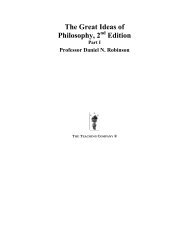English idioms in the first language and second language lexicon: a ...
English idioms in the first language and second language lexicon: a ...
English idioms in the first language and second language lexicon: a ...
You also want an ePaper? Increase the reach of your titles
YUMPU automatically turns print PDFs into web optimized ePapers that Google loves.
340 <strong>English</strong> <strong>idioms</strong> <strong>in</strong> <strong>the</strong> L1 <strong>and</strong> L2 <strong>lexicon</strong>tendency to judge <strong>idioms</strong> as be<strong>in</strong>g decomposable ra<strong>the</strong>r thannondecomposable, <strong>in</strong>dependently of <strong>the</strong> syntactic structure of <strong>the</strong><strong>idioms</strong>.The 75% agreement criterion was used <strong>in</strong> native speaker studies(e.g., Gibbs <strong>and</strong> Nayak, 1989; Titone <strong>and</strong> Conn<strong>in</strong>e, 1994) to get aclearer picture of <strong>the</strong> distribution. The criterion identifies <strong>idioms</strong>that accord<strong>in</strong>g to 75% of <strong>the</strong> participants belong to one class or <strong>the</strong>o<strong>the</strong>r. Us<strong>in</strong>g <strong>the</strong> 75% agreement criterion, <strong>in</strong> Study 1 33.2% (or 63<strong>idioms</strong>) were rated as decomposable <strong>and</strong> 15.3 % (29) asnondecomposable. In Study 2, 29.2% (38) were rated as decomposable<strong>and</strong> 17.7% (23) as nondecomposable. In bothstudies, about half of <strong>the</strong> <strong>idioms</strong> (Study 1: 51.5%, 98, Study 2: 53.1%,69) could not be classified accord<strong>in</strong>g to <strong>the</strong> 75% criterion. As <strong>the</strong><strong>in</strong>itial decomposability-rat<strong>in</strong>g task already <strong>in</strong>dicated, nonnativestend to judge <strong>idioms</strong> as be<strong>in</strong>g decomposable ra<strong>the</strong>r thannondecomposable.Note that <strong>the</strong> lack of more clear-cut results is not due to <strong>the</strong>nonnative sample, but is ra<strong>the</strong>r characteristic of <strong>the</strong> task <strong>in</strong> question,as <strong>the</strong> results of <strong>the</strong> native participants discussed <strong>in</strong> <strong>the</strong> nextparagraph show. In general – i.e., <strong>in</strong> show<strong>in</strong>g an asymmetricaldivision – <strong>the</strong> nonnative results support <strong>the</strong> f<strong>in</strong>d<strong>in</strong>gs reported byTitone <strong>and</strong> Conn<strong>in</strong>e (1994) ra<strong>the</strong>r than those reported by Gibbs<strong>and</strong> Nayak (1989). However, <strong>the</strong> nonnative judgements are a mirrorimage of <strong>the</strong> native judgements.The analysis of <strong>the</strong> biographical questionnaire identifiedfrequency of read<strong>in</strong>g <strong>English</strong> texts <strong>and</strong> <strong>the</strong> type of text as <strong>the</strong> factorsthat <strong>in</strong>fluenced <strong>the</strong> participants’ decomposability-rat<strong>in</strong>g behaviourmost. Recall that <strong>in</strong> Study 1 <strong>the</strong> <strong>in</strong>itial dichotomous decomposability-rat<strong>in</strong>gtask for all nonnative participants yielded a meanproportion of 56.5% of <strong>idioms</strong> as decomposable. German speakersof <strong>English</strong> who read literary <strong>English</strong> texts daily (23 participants)only judged 49.8% of <strong>idioms</strong> to be decomposable. That means that<strong>the</strong>ir judgements are closer to those that native speakers display(41.9%; Titone <strong>and</strong> Conn<strong>in</strong>e, 1994; see below). This h<strong>in</strong>ts at a k<strong>in</strong>dof frequency effect that might lead to specific lexical representations(for a discussion of familiarity, see next paragraph).4 Comparison of native <strong>and</strong> nonnative judgements: norm-<strong>idioms</strong>Titone <strong>and</strong> Conn<strong>in</strong>e (1994) reported descriptive norms for 171idiomatic expressions, e.g., judgements on (de)composability <strong>and</strong>familiarity given by native speakers of <strong>English</strong>. These 171 <strong>idioms</strong>(referred to as ‘norm-<strong>idioms</strong>’), form a subset of <strong>the</strong> 320 <strong>idioms</strong> thatwere judged <strong>in</strong> Studies 1 <strong>and</strong> 2 by nonnative speakers of <strong>English</strong>.Downloaded from http://slr.sagepub.com at Shanghai Jiaotong University on March 7, 2009














